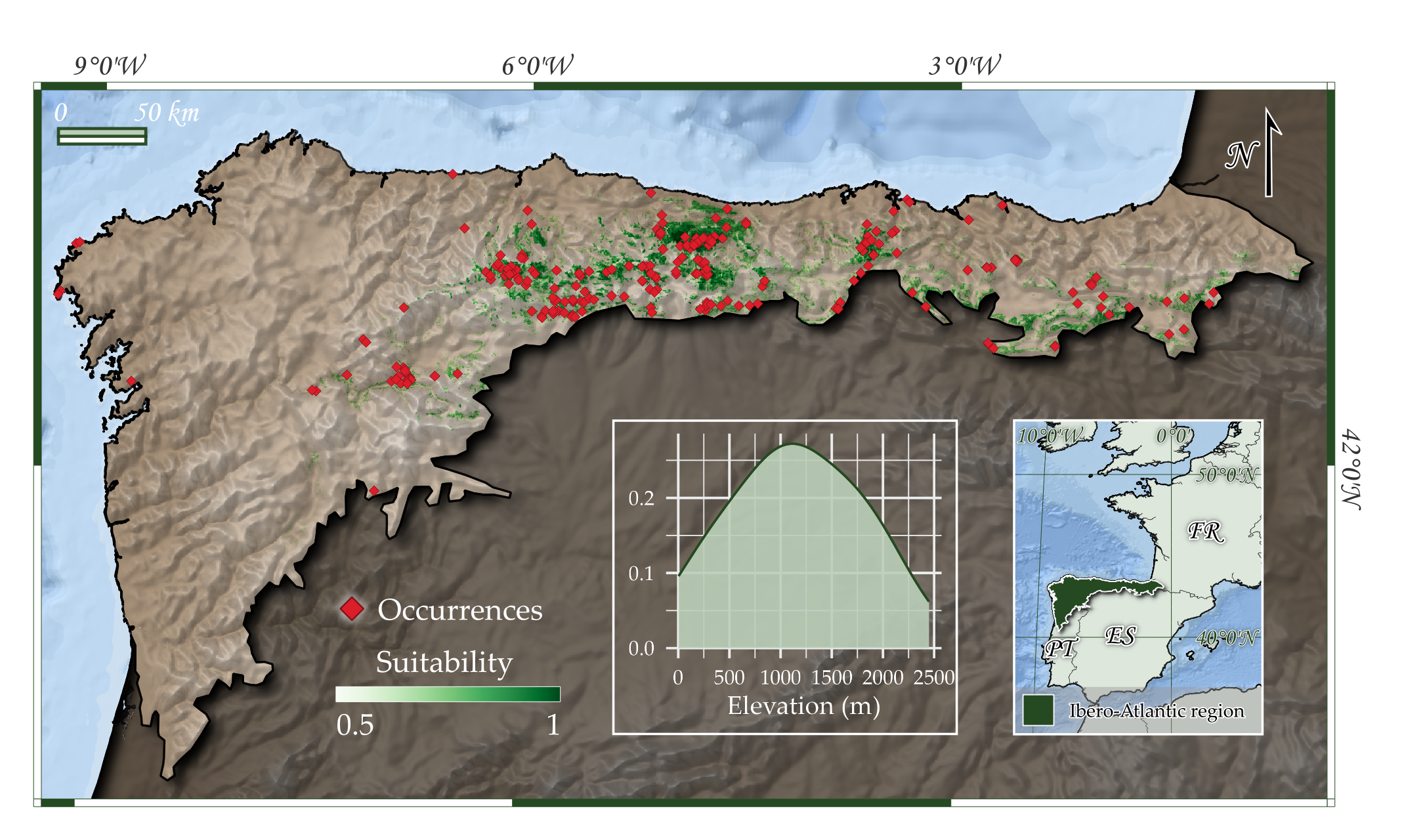U381 Roquedos calcáreos cantábricos
Description
Comunidades discontinuas que habitan las grietas y repisas de roquedos calcáreos por lo demás desnudos, ricas en especies, muchas endémicas. Aunque acogen cierta variación geográfica, topográfica y altitudinal que justificará el reconocimiento de subunidades, hay un cierto número de plantas muy especializadas en estos medios y de amplia distribución en todo este complejo azonal que le dan coherencia florística. El muy analítico esquema originald e EUNIS, nuestras comunidades solo son reconocidas como distintas a nivel VI bajo el código U38171 (“Oro-Cantabrian calcareous cliffs).
Floristic Composition
Frequent species
Asplenium trichomanes
0.39,
Erinus alpinus
0.31,
Asplenium ceterach
0.27,
Asplenium ruta-muraria
0.25,
Sedum dasyphyllum
0.25,
Saxifraga canaliculata
0.24,
Arenaria grandiflora
0.23,
Sedum album
0.19,
Campanula rotundifolia aggr.
0.19,
Crepis albida
0.17,
Chaenorhinum origanifolium
0.16,
Saxifraga paniculata
0.15,
Galium mollugo aggr.
0.15,
Globularia repens
0.14,
Festuca burnatii
0.13,
Hieracium mixtum aggr.
0.13,
Cystopteris fragilis aggr.
0.13,
Asplenium viride
0.12,
Pimpinella tragium
0.11,
Anemone pavoniana
0.11,
Hornungia alpina
0.1,
Centranthus lecoqii
0.1,
Campanula adsurgens
0.1,
Saxifraga trifurcata
0.1,
Sedum sediforme
0.09,
Globularia nudicaulis
0.09,
Campanula arvatica aggr.
0.08,
Rumex scutatus
0.08,
Valeriana apula
0.08,
Saxifraga cuneata
0.08,
Phagnalon saxatile
0.08,
Koeleria vallesiana
0.06,
Festuca hystrix
0.06,
Agrostis schleicheri
0.06,
Allosorus acrosticus
0.06,
Melica ciliata
0.06,
Matthiola perennis
0.06,
Leontodon farinosus
0.06,
Draba dedeana
0.06,
Carex sempervirens
0.06,
Campanula erinus
0.06,
Galium pumilum aggr.
0.06,
Asperula hirta
0.06,
Saxifraga babiana
0.05,
Dryopteris mindshelkensis
0.05,
Anthyllis vulneraria
0.05
view more...
Indicator species
Asplenium trichomanes 0.33
,
Asplenium ceterach 0.26
,
Erinus alpinus 0.24
,
Saxifraga canaliculata 0.24
,
Sedum dasyphyllum 0.24
,
Asplenium ruta-muraria 0.23
,
Campanula rotundifolia aggr. 0.17
,
Arenaria grandiflora 0.16
,
Sedum album 0.16
,
Crepis albida 0.15
,
Saxifraga paniculata 0.15
,
Globularia repens 0.14
,
Chaenorhinum origanifolium 0.14
,
Festuca burnatii 0.13
,
Galium mollugo aggr. 0.13
,
Hieracium mixtum aggr. 0.13
,
Asplenium viride 0.12
,
Cystopteris fragilis aggr. 0.11
,
Anemone pavoniana 0.11
,
Pimpinella tragium 0.1
,
Saxifraga trifurcata 0.1
,
Campanula adsurgens 0.09
,
Valeriana apula 0.08
,
Saxifraga cuneata 0.08
,
Globularia nudicaulis 0.07
,
Campanula arvatica aggr. 0.07
,
Phagnalon saxatile 0.06
,
Sedum sediforme 0.06
,
Agrostis schleicheri 0.06
,
Festuca hystrix 0.06
,
Leontodon farinosus 0.06
,
Allosorus acrosticus 0.06
,
Matthiola perennis 0.06
,
Koeleria vallesiana 0.06
,
Carex sempervirens 0.06
,
Asperula hirta 0.05
,
Draba dedeana 0.05
,
Saxifraga babiana 0.05
,
Hornungia alpina 0.05
,
Dryopteris mindshelkensis 0.05
,
Potentilla nivalis 0.04
,
Teucrium pyrenaicum 0.04
,
Polypodium cambricum 0.04
,
Centranthus lecoqii 0.04
,
Campanula erinus 0.04
,
Silene saxifraga 0.04
,
Dethawia splendens 0.04
,
Galium pumilum aggr. 0.04
,
Hieracium amplexicaule aggr. 0.04
,
Urtica dioica 0.04
view more...
Regional distribution
